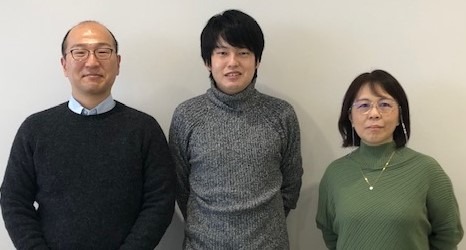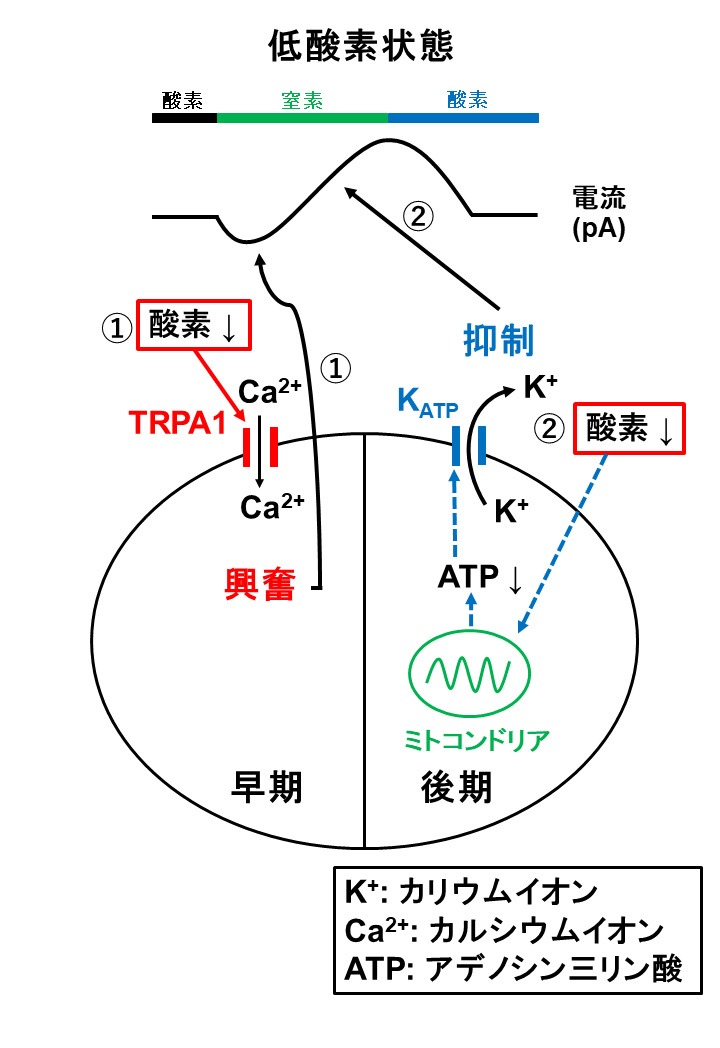Achievements
A paper clarifying the previously unknown role of the central TRPA1 channel has been published in the international academic journal "Scientific Reports"
A paper by Associate Professor Kohei Koga (Division of Neurophysiology) and Associate Professor Akiko Arata (Division of Biofunction) of School of Medicine Department of Physiology Faculty of Medicine, has been published in the international academic journal Scientific Reports (20 February 2023).
This research was conducted in collaboration with Kwansei Gakuin University and Hirosaki University as part of the Hyogo Innovative Challenge project. TRPA1 (Transient receptor potential ankyrin 1) is widely known as a channel that senses cold and pain in peripheral nerves, but this study revealed that central TRPA1 channels quickly sense hypoxia that occurs nearby and play a role in transmitting excitation signals. For more information, please see below.
Topic
TRPA1 as an O 2 sensor detects microenvironmental hypoxia in the mice anterior cingulate cortex.
Author of the paper
Ryo Kawabata (1) (2), Shuji Shimoyama (3), Shinya Ueno (3), Ikuko Yao (1), Akiko Arata (4) (★), Kohei Koga (2) (★)
* (1) Kwansei Gakuin University, Graduate School of Science and Engineering (2) Hyogo Medical University School of Medicine, Department of Physiology, Division of Physiology (3) Hirosaki University Graduate School of Medicine Department of Neurophysiology (4) Hyogo Medical University School of Medicine, Department of Physiology, Division of Biofunction

(From left) Associate Professor Koga, Ryo Kawabata, and Associate Professor Arata
Research Summary
TRPA1 is widely known as a channel that detects cold and pain in peripheral nerves, but the role of TRPA1 expressed in the central nervous system remained unclear.
In this study, our research group used slice preparations from the anterior cingulate cortex, a brain region involved in emotion and pain, to analyze how TRPA1 affects neuronal activity and synaptic transmission using an intracellular recording method called the patch clamp method. It was found that activating TRPA1 with a TRPA1 agonist excites neurons in the anterior cingulate cortex, affecting the frequency and shape of action potentials. Furthermore, as a result of examining the Physiology significance of TRPA1 in the anterior cingulate cortex under hypoxic conditions, it was revealed that neurons showed a biphasic response to hypoxia, with TRPA1 involved in early excitation and ATP-sensitive potassium channels (KATP) involved in late inhibition. This revealed that central TRPA1 channels play a role in quickly detecting hypoxia occurring nearby and transmitting excitation signals.

Research Background
So far, research on TRPA1 has been mainly conducted on peripheral nerves, and it is widely known as a sensor that detects temperature and pain. On the other hand, Laboratory of Anatomy studies have shown that TRPA1 is also expressed in the central nervous system, but the function of TRPA1 in the central nervous system was not well understood. TRPA1 is known to be activated by various things such as cold and wasabi, but it is also known that TRPA1 senses oxygen in peripheral nerves. Since the brain is an organ that accounts for approximately 20% of the oxygen consumption of the entire body, we also conducted research with the possibility that TRPA1 may play a role as an oxygen sensor that detects changes in oxygen partial pressure in the brain.
Research Methods and Results
We prepared brain slices including the anterior cingulate cortex from adult male mice. We performed whole-cell patch clamp recordings from pyramidal cells in layer II/III and investigated the effects of perfusion administration of TRPA1 agonists on Physiology properties such as resting membrane potential and action potential generation, as well as on excitatory and inhibitory synaptic transmission at the single-cell level.
The TRPA1 agonist generated an inward current but had no effect on spontaneous excitatory or inhibitory synaptic transmission. This suggests that TRPA1 may be expressed in pyramidal cells. Furthermore, when examining the effects on action potentials, it was found that the TRPA1 agonist suppressed the frequency of action potentials and also changed their shape.
Next, we investigated the changes that occurred when pyramidal cells in the anterior cingulate gyrus were exposed to an acute hypoxic environment. When the artificial cerebrospinal fluid (ASF) perfusion fluid, which is normally bubbled with 95% oxygen, was replaced with 95% nitrogen, a biphasic response occurred, with early excitation and later inhibition. When we investigated the mechanism of this biphasic response, we found that TRPA1 is important for early excitation, and the opening of KATP channels is required for late inhibition.
Future challenges
These results shed light on part of the role of TRPA1 in neurons in the anterior cingulate cortex. Under acute hypoxic conditions, a biphasic response occurred in neurons, and in particular, in the early hypoxic environment, TRPA1 sensed the hypoxic state and opened, while in the later stage, KATP channels opened, resulting in a biphasic response.
In the future, we plan to investigate how TRPA1 and KATP channels in the brain detect changes in oxygen partial pressure and how the shape of action potentials generated in nerve cells changes, including the effects of brain stress, which is closely related to hypoxia. Furthermore, we plan to clarify the relationship between cerebral ischemia model animals and these channels to determine how TRPA1 and KATP channels are involved in pathological conditions such as hypoxic encephalopathy.
Source of research funds etc.
Research expenses related to HIC business
Mochida Memorial Foundation (2023): Research Director Kohei Koga
Grant-in-Aid for Scientific Research (20H03777): Principal Investigator Kohei Koga
Grant-in-Aid for Scientific Research (21K19460): Principal Investigator Kohei Koga
Grant-in-Aid for Scientific Research (22H03446): Principal Investigator Koichi Noguchi